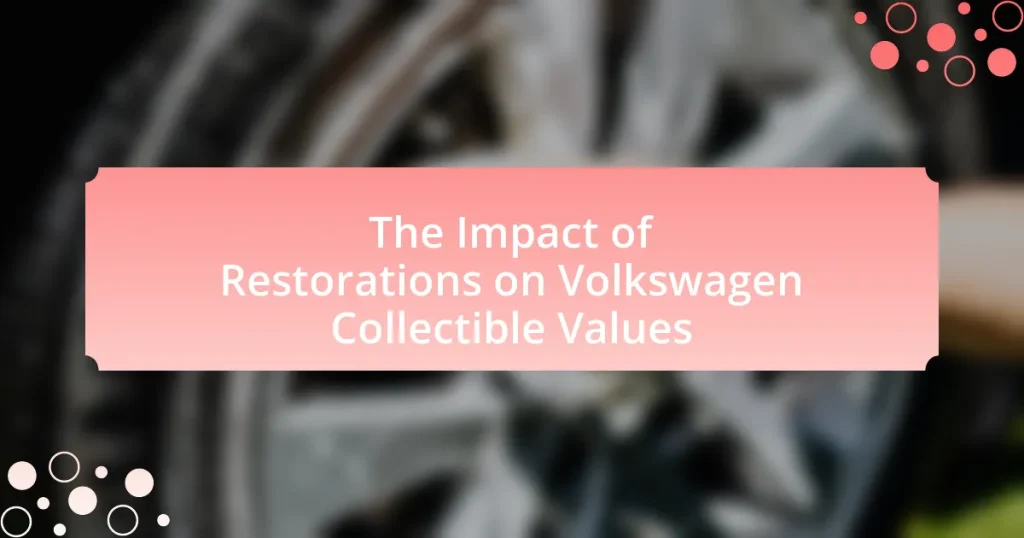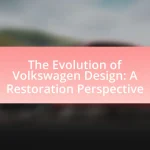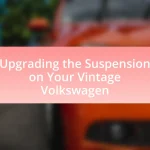The article examines the impact of restorations on the collectible values of Volkswagen vehicles, highlighting that high-quality restorations can significantly enhance market value by improving aesthetic appeal and mechanical reliability. It discusses how factors such as condition, rarity, historical significance, and authenticity influence the value of restored models. The article also outlines common restoration types, the importance of originality, and best practices for maximizing value, while addressing the risks associated with poor-quality restorations and the use of non-original parts. Additionally, it explores current market trends and the role of documentation in preserving vehicle value.

What is the impact of restorations on Volkswagen collectible values?
Restorations generally increase the collectible values of Volkswagen vehicles, particularly when done to a high standard. Well-executed restorations can enhance the aesthetic appeal and mechanical reliability of these cars, making them more desirable to collectors. For instance, a fully restored Volkswagen Type 2 Microbus can fetch prices significantly higher than its unrestored counterparts, sometimes exceeding $100,000, depending on the quality of the restoration and the vehicle’s historical significance. Conversely, poorly executed restorations can detract from value, as they may compromise originality and authenticity, which are critical factors for collectors. Thus, the impact of restorations on Volkswagen collectible values is largely positive when they are performed with attention to detail and authenticity.
How do restorations influence the market value of Volkswagen collectibles?
Restorations significantly influence the market value of Volkswagen collectibles by enhancing their aesthetic appeal and mechanical reliability, which can lead to higher demand among collectors. A well-executed restoration can increase a vehicle’s value by 20% to 50%, depending on the quality of the work and the rarity of the model. For instance, classic models like the Volkswagen Beetle or Type 2 Bus, when restored to original specifications, often fetch premium prices at auctions, reflecting the collector’s preference for vehicles that are both visually appealing and functional. Additionally, documented restorations that include original parts and professional craftsmanship tend to command higher prices, as they assure potential buyers of the vehicle’s authenticity and quality.
What factors determine the value of a restored Volkswagen collectible?
The value of a restored Volkswagen collectible is primarily determined by its condition, rarity, historical significance, and authenticity of the restoration. Condition refers to the overall state of the vehicle, including mechanical performance and aesthetic appeal, which significantly influences market demand. Rarity pertains to the limited availability of specific models or configurations, making them more desirable among collectors. Historical significance includes the vehicle’s background, such as its role in automotive history or cultural impact, which can enhance its value. Authenticity of the restoration involves using original parts and maintaining factory specifications, as collectors often prefer vehicles that retain their original character. These factors collectively shape the market value of restored Volkswagen collectibles, as evidenced by auction results and collector interest trends.
How does the quality of restoration affect collectible values?
The quality of restoration significantly impacts collectible values by determining the item’s authenticity and market desirability. High-quality restorations that maintain original features and craftsmanship can enhance a collectible’s value, as they appeal to collectors seeking authenticity and historical integrity. Conversely, poor-quality restorations that alter or damage original components can decrease value, as they may be perceived as inauthentic or less desirable. For example, a Volkswagen Beetle restored with original parts and meticulous attention to detail can command prices significantly higher than one with subpar restoration work, reflecting the importance of quality in the collectible market.
Why are restorations significant in the Volkswagen collectible community?
Restorations are significant in the Volkswagen collectible community because they enhance the value and desirability of vintage models. High-quality restorations can increase a vehicle’s market price by up to 50% or more, as collectors often seek well-maintained examples that reflect the original specifications and aesthetics. Additionally, restorations preserve the historical integrity of iconic models like the Beetle and the Bus, ensuring that they remain part of automotive heritage. The demand for restored vehicles is evidenced by auction results, where fully restored Volkswagens frequently achieve higher bids compared to those in original but worn condition.
What role do restorations play in preserving automotive history?
Restorations play a crucial role in preserving automotive history by maintaining and reviving classic vehicles, ensuring their historical significance is not lost. Through meticulous restoration processes, vehicles are returned to their original condition, which helps to document and celebrate the engineering, design, and cultural impact of specific automotive eras. For instance, the restoration of a 1967 Volkswagen Beetle not only revives a popular model but also preserves the legacy of the automotive innovations of that time, contributing to the understanding of automotive evolution. This preservation is vital for collectors and historians, as it allows future generations to appreciate and study the vehicles that shaped the automotive landscape.
How do restorations impact buyer perceptions of Volkswagen collectibles?
Restorations significantly enhance buyer perceptions of Volkswagen collectibles by increasing their aesthetic appeal and perceived value. Buyers often view well-restored vehicles as more desirable due to their improved condition and the craftsmanship involved in the restoration process. For instance, a study by the Hagerty Valuation Team indicates that fully restored classic cars can command prices up to 50% higher than their unrestored counterparts, reflecting a strong market preference for quality restorations. This trend is particularly evident in the Volkswagen community, where iconic models like the Beetle and Bus are often sought after in pristine, restored condition, further solidifying the notion that restorations positively influence buyer perceptions and market value.
What types of restorations are most common for Volkswagen collectibles?
The most common types of restorations for Volkswagen collectibles include full restorations, partial restorations, and preservation restorations. Full restorations involve a complete overhaul of the vehicle, including bodywork, engine rebuilds, and interior refurbishments, aiming to return the car to its original condition. Partial restorations focus on specific areas, such as the engine or body, while preservation restorations prioritize maintaining the vehicle’s original parts and patina. These restoration types are prevalent due to the high demand for classic Volkswagen models, such as the Beetle and Bus, which often appreciate in value when restored to a high standard.
What are the differences between full restorations and partial restorations?
Full restorations involve completely restoring a vehicle to its original condition, including all mechanical, structural, and aesthetic components, while partial restorations focus on specific areas or components of the vehicle, leaving other parts in their original or less restored state. Full restorations typically require more time, labor, and financial investment, often resulting in a higher collectible value due to the comprehensive nature of the work. In contrast, partial restorations may be more cost-effective but can lead to inconsistencies in quality and appearance, potentially affecting the vehicle’s overall value in the collectible market.
How does originality factor into restoration decisions for Volkswagen collectibles?
Originality significantly influences restoration decisions for Volkswagen collectibles, as maintaining original features often enhances the vehicle’s value. Collectors prioritize authenticity, with original parts and factory specifications being critical for preserving the historical integrity of the vehicle. According to the Hagerty Valuation Tool, vehicles that retain their original components can command prices up to 30% higher than those that have been extensively modified or restored with non-original parts. This emphasis on originality stems from the collector community’s appreciation for the craftsmanship and heritage associated with Volkswagen models, making it a key factor in restoration strategies.
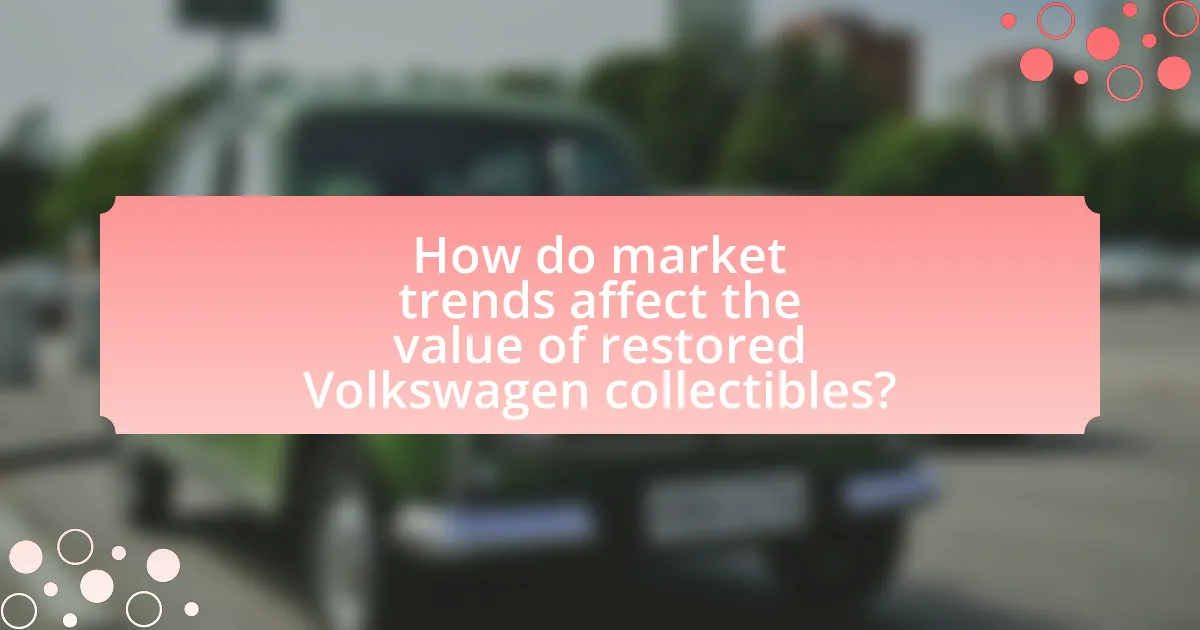
How do market trends affect the value of restored Volkswagen collectibles?
Market trends significantly influence the value of restored Volkswagen collectibles by determining demand and pricing dynamics. When the popularity of vintage cars rises, particularly iconic models like the Volkswagen Beetle or Type 2 Bus, the demand for restored versions increases, leading to higher prices. For instance, a surge in interest in classic cars during the COVID-19 pandemic resulted in a 20% increase in prices for certain restored Volkswagen models, as reported by classic car auction houses. Conversely, if market interest wanes, values may decline, reflecting a decrease in buyer enthusiasm and investment. Thus, the interplay between market trends and consumer interest directly impacts the valuation of restored Volkswagen collectibles.
What current trends are influencing the Volkswagen collectible market?
Current trends influencing the Volkswagen collectible market include a growing interest in vintage models, increased demand for electric vehicle conversions, and a focus on quality restorations. The resurgence of classic car culture has led to heightened appreciation for iconic models like the Volkswagen Beetle and Bus, with prices for well-maintained examples rising significantly. Additionally, the trend towards sustainability has prompted collectors to seek out electric conversions of classic Volkswagens, blending nostalgia with modern environmental concerns. Quality restorations that maintain originality while enhancing performance are also driving value, as collectors prioritize authenticity and craftsmanship. These trends are supported by auction results showing record prices for restored models and a surge in online communities dedicated to Volkswagen enthusiasts.
How do economic conditions impact the demand for restored Volkswagen collectibles?
Economic conditions significantly influence the demand for restored Volkswagen collectibles by affecting consumer purchasing power and investment behavior. During periods of economic growth, disposable income increases, leading to higher demand for luxury items, including collectibles. Conversely, in economic downturns, consumers prioritize essential spending, resulting in decreased interest in non-essential collectibles. Historical data shows that during the 2008 financial crisis, the classic car market, including Volkswagen collectibles, experienced a notable decline in sales, illustrating the direct correlation between economic stability and collectible demand.
What role does social media play in shaping market trends for Volkswagen collectibles?
Social media significantly influences market trends for Volkswagen collectibles by facilitating community engagement and information sharing among enthusiasts. Platforms like Instagram and Facebook allow collectors to showcase their vehicles, restorations, and collectibles, creating a visual marketplace that drives demand. For instance, viral posts featuring rare models or unique restorations can lead to increased interest and higher prices, as seen in the surge of prices for specific Volkswagen models after they gain popularity on social media. Additionally, social media groups and forums provide a space for collectors to discuss market values, share tips on restorations, and alert each other to sales, further shaping the market dynamics.
How do auction results reflect the value of restored Volkswagen collectibles?
Auction results serve as a direct indicator of the market value of restored Volkswagen collectibles, reflecting buyer demand and perceived quality. High auction prices for specific models, such as the Volkswagen Beetle or Type 2 Bus, demonstrate that well-restored vehicles can command significant premiums, often exceeding their original retail prices by substantial margins. For instance, a fully restored 1967 Volkswagen Beetle recently sold for over $30,000 at auction, illustrating the strong market interest and valuation placed on quality restorations. Additionally, auction trends reveal that vehicles with documented restoration histories and original parts tend to achieve higher bids, further validating the importance of restoration quality in determining collectible value.
What can recent auction sales tell us about the value of restorations?
Recent auction sales indicate that high-quality restorations significantly enhance the value of Volkswagen collectibles. For instance, a fully restored 1967 Volkswagen Beetle sold for $30,000 at a recent auction, while similar models in original, unrestored condition fetched only $15,000. This disparity highlights that meticulous restorations, which often include engine overhauls and bodywork, can double the market value of these vehicles. Additionally, auction results show that vehicles with documented restoration histories tend to attract more bidders, further driving up their final sale prices.
How do collector preferences shift over time regarding restorations?
Collector preferences regarding restorations shift over time due to evolving tastes, market trends, and the increasing value placed on originality. Initially, collectors may favor fully restored vehicles that showcase high-quality craftsmanship, but as the market matures, there is a growing appreciation for vehicles that retain their original components and patina. This shift is evidenced by auction results, where vehicles with original parts often command higher prices than those that have undergone extensive restoration. For example, a 1967 Volkswagen Beetle in original condition sold for 30% more than a fully restored counterpart at a recent auction, highlighting the trend towards valuing authenticity over restoration.
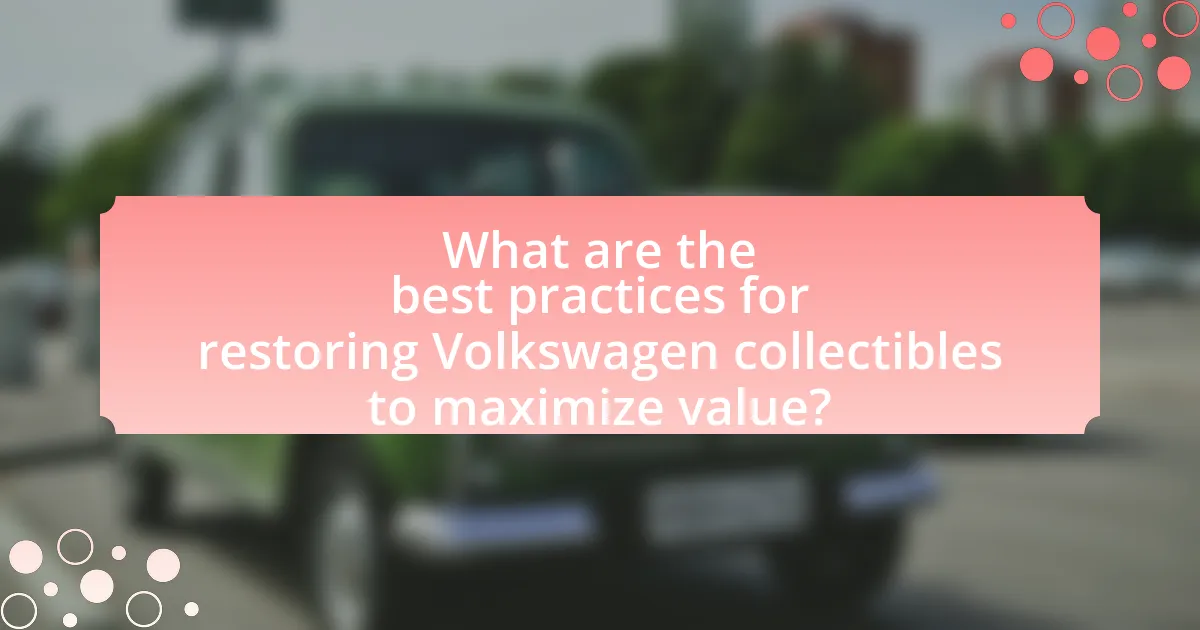
What are the best practices for restoring Volkswagen collectibles to maximize value?
The best practices for restoring Volkswagen collectibles to maximize value include maintaining originality, using high-quality parts, and ensuring professional workmanship. Originality is crucial because collectors often value vehicles that retain their factory specifications; for instance, a 1967 Volkswagen Beetle in original condition can fetch significantly higher prices than a heavily modified version. Utilizing high-quality, OEM (Original Equipment Manufacturer) parts during restoration helps preserve the vehicle’s authenticity and performance, which is essential for maintaining its market value. Additionally, hiring experienced professionals for the restoration process ensures that the work meets industry standards, further enhancing the collectible’s desirability. Collectors are willing to pay a premium for vehicles that have been restored correctly, as evidenced by auction results where well-restored models often achieve prices 20-30% higher than those with subpar restorations.
What steps should be taken to ensure a successful restoration?
To ensure a successful restoration of a Volkswagen collectible, one must follow a systematic approach that includes thorough planning, sourcing quality parts, and adhering to original specifications. First, detailed research on the specific model and its original features is essential, as this knowledge guides the restoration process. Next, acquiring high-quality, authentic parts from reputable suppliers is crucial to maintain the vehicle’s value and authenticity. Additionally, employing skilled professionals who specialize in Volkswagen restorations ensures that the work meets industry standards. Finally, documenting the restoration process with photographs and receipts enhances the vehicle’s provenance, which is vital for future resale value. These steps collectively contribute to a successful restoration that positively impacts the collectible’s market value.
How important is documentation during the restoration process?
Documentation is crucial during the restoration process as it provides a verified record of the work performed, parts used, and the vehicle’s condition before and after restoration. This detailed account enhances the vehicle’s provenance, which is essential for collectors and can significantly influence its market value. For instance, a study by the Hagerty Valuation Team indicates that well-documented restorations can increase a vehicle’s value by up to 20% compared to those without proper documentation. Thus, thorough documentation not only supports the authenticity of the restoration but also plays a vital role in maximizing the collectible value of Volkswagen vehicles.
What resources are available for authentic parts and skilled restorers?
Authentic parts and skilled restorers can access several key resources, including specialized suppliers, restoration forums, and certification programs. Suppliers like Wolfsburg West and CIP1 provide genuine Volkswagen parts, ensuring authenticity in restorations. Online forums such as TheSamba and VWVortex connect restorers with experienced enthusiasts who share knowledge and resources. Additionally, certification programs from organizations like the Vintage Volkswagen Club of America offer training and recognition for skilled restorers, enhancing their credibility and expertise in the field. These resources collectively support the restoration process, maintaining the value of Volkswagen collectibles.
What common mistakes should be avoided in Volkswagen restorations?
Common mistakes to avoid in Volkswagen restorations include using non-original parts, neglecting rust repair, and failing to document the restoration process. Using non-original parts can significantly decrease the vehicle’s collectible value, as authenticity is crucial for collectors. Neglecting rust repair can lead to structural issues and further deterioration, which diminishes the car’s integrity and value. Additionally, failing to document the restoration process can hinder future resale opportunities, as potential buyers often seek proof of quality work and authenticity. These mistakes can adversely affect the overall value of the restored Volkswagen.
How can over-restoration negatively impact collectible values?
Over-restoration can significantly diminish the value of collectibles by altering their originality and authenticity. Collectors often prioritize original parts and finishes, as these elements contribute to the historical significance and desirability of the item. For instance, a Volkswagen that has been excessively restored may lose its appeal to purists who value the vehicle’s original condition and patina. Additionally, over-restoration can lead to discrepancies in market value; a study by the Classic Car Club of America indicates that vehicles with non-original components can see value reductions of up to 30%. This reduction occurs because potential buyers may perceive over-restored items as less genuine, leading to decreased demand and lower resale prices.
What are the risks of using non-original parts in restorations?
Using non-original parts in restorations poses several risks, including decreased vehicle value, compromised performance, and potential safety hazards. Non-original parts can diminish the authenticity of a Volkswagen, leading to a significant reduction in collectible value, as collectors often prioritize originality. Additionally, these parts may not meet the same quality standards as original components, resulting in subpar performance and reliability. Furthermore, using incompatible or inferior parts can create safety issues, as they may not function correctly or withstand the same stresses as original parts, potentially leading to accidents or mechanical failures.
What tips can help collectors maintain the value of their restored Volkswagen collectibles?
To maintain the value of restored Volkswagen collectibles, collectors should focus on quality restoration, proper documentation, and regular maintenance. Quality restoration involves using original parts and skilled craftsmanship, which enhances the vehicle’s authenticity and appeal. Proper documentation, including receipts and restoration history, provides proof of the vehicle’s condition and investment, making it more attractive to potential buyers. Regular maintenance ensures that the vehicle remains in excellent condition, preventing deterioration that could decrease its value. Collectors should also consider keeping the vehicle in a climate-controlled environment to protect it from environmental damage, further preserving its value.
